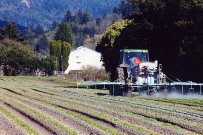The two-year-old water testing results are finally in: “28 quantifiable concentrations of 11 different detected pesticides … acute [and] chronic reproductive toxicity” in the salmonid food chain, elevated copper and nutrients. Yet the North Coast Regional Water Quality Control Board, in its just-released report on Smith River estuary water testing that was conducted in 2013, says the toxicity and assault on the river’s salmonid food chain are somehow unrelated to the 300,000 pounds of highly toxic pesticides applied annually to Easter lily fields that surround the Smith River estuary. This despite the fact that eight of the 11 pesticides found in surface waters are currently used on lily fields, or have been in the past. (Siskiyou Land Conservancy released this information in September 2014, much to the chagrin of the Water Board.) “The low level concentrations of each of the measured constituents [pesticides] do not appear to be directly responsible for the lowered reproduction rates,” says the report in its rather dubious conclusion. While we appreciate the water testing (which occurred in large part due to pressure from SLC) and the state’s attention to the potential of a chemical catastrophe at the Smith River estuary, the process thus far has been dense with bureaucratic layering, inexplicable delays, and scientific denial. The bottom line is that the Water Board is developing a “permit” that will allow lily growers to continue business as usual. Siskiyou Land Conservancy is not content to allow this to occur. SLC is a stakeholder in the permit process, so we’ll keep you posted.

